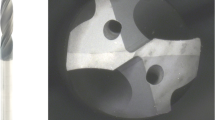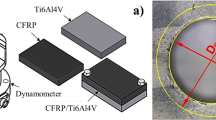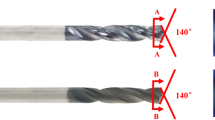Abstract
Contrast experiments, in which CFRP and 7075 aluminum alloy stacked materials were drilled with different structure drills respectively, were carried out to assess how process parameters and tools affected hole accuracy, roughness, and burr height as well as cutting force. The results showed that comprehensive cutting ability of the new structure CVD diamond-coated drill was significantly higher than that of the traditional twist drill when drilling CFRP/Al stacks without coolant. The best process parameters were at the speed of 4000 r/min, the feed rate of 0.04 mm/r, with which the aperture accuracy could reach H8, composite shrinkage could be controlled in less than 5 μm and hole wall roughness also meet industry needs (CFRP: Ra ≤ 3.2 μm, Al: Ra ≤ 1.6 μm). Matrix cracking and larger rolled-back burrs would be apparent with the tool wear. On the premise of ensuring the quality and accuracy, the cutting tool could be used for 400 holes at least.
Similar content being viewed by others
References
Chen WC (1997) Some experimental investigations in the drilling of carbon fiber-reinforced plastic (CFRP) composite laminates. Int J Mach Tools Manuf 37(8):1097–1108
Shyha IS, Aspinwall DK, Soo SL, Bradley S (2009) Drill geometry and operating effects when cutting small diameter holes in CFRP. Int J Mach Tools Manuf 49(12):1008–1014
Amaro AM, Reis PNB, de Moura M, Neto MA (2013) Influence of open holes on composites delamination induced by low velocity impact loads. Compos Struct 97:239–244
Wang DH, Ramulu M, Arola D (1995) Orthogonal cutting mechanisms of graphite/epoxy composite. Part I: unidirectional laminate. Int J Mach Tools Manuf 35(12):1623–1638
Tsao CC, Hocheng H (2008) Evaluation of thrust force and surface roughness in drilling composite material using Taguchi analysis and neural network. J Mater Process Technol 203(1):342–348
Davim JP, Reis P (2003) Study of delamination in drilling carbon fiber reinforced plastics (CFRP) using design experiments. Compos Struct 59(4):481–487
Rahmé P, Landon Y, Lachaud F, Piquet R, Lagarrigue P (2011) Analytical models of composite material drilling. Int J Adv Manuf Technol 52(5–8):609–617
Furet B, Jolivel B, Le Borgne D (2005) Milling and drilling of composite materials for the aeronautics. JEC Compos 18:41–44
Bhatnagar N, Jalutharia MK, Singh I (2008) Prediction of thrust force and torque when drilling composite materials. Int J Mater Prod Technol 32(2):213–225
Zitoune R, Krishnaraj V, Collombet F (2010) Study of drilling of composite material and aluminum stack. Compos Struct 92(5):1246–1255
Zitoune R, Collombet F (2009) Influence of machining quality on composite part manufacturing. In: Davim JP (ed) Drilling of composite materials, Materials and manufacturing technology. Nova Publishers, New York
Rawat S, Attia H (2009) Characterization of the dry high speed drilling process of woven composites using machinability maps approach. CIRP Ann Manuf Technol 58(1):105–108
Qi Z, Zhang K, Li Y, Cheng H (2014) Critical thrust force predicting modeling for delamination-free drilling of metal-FRP stacks. Compos Struct 107:604–609
Montoya M, Calamaz M, Gehin D, Girot F (2013) Evaluation of the performance of coated and uncoated carbide tools in drilling thick CFRP/aluminum alloy stacks. Int J Adv Manuf Technol 68:2111–2120
Brinksmeier E, Janssen R (2002) Drilling of multi-layer composite materials consisting of carbon fiber reinforced plastics (CFRP), titanium and aluminum alloys. CIRP Ann Manuf Technol 51(1):87–90
Denkena B, Boehnke D, Dege JH (2008) Helical milling of CFRP–titanium layer compounds. CIRP J Manuf Sci Technol 1(2):64–69
Kuo CL, Soo SL, Aspinwall DK, Thomas W, Bradley S, Pearson D, M’Saoubi R, Leahy W (2014) The effect of cutting speed and feed rate on hole surface integrity in single-shot drilling of metallic-composite stacks. Procedia CIRP 13:405–410
Ramulu M, Branson T, Kim D (2001) A study on the drilling of composite and titanium stacks. Compos Struct 54(1):67–77
Author information
Authors and Affiliations
Corresponding author
Rights and permissions
About this article
Cite this article
Zhang, L., Liu, Z., Tian, W. et al. Experimental studies on the performance of different structure tools in drilling CFRP/Al alloy stacks. Int J Adv Manuf Technol 81, 241–251 (2015). https://doi.org/10.1007/s00170-015-6955-z
Received:
Accepted:
Published:
Issue Date:
DOI: https://doi.org/10.1007/s00170-015-6955-z




